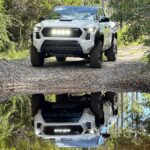The 2009 Cadillac CTS-V is a performance sedan that already packs a serious punch straight from the factory. However, for those seeking to push the boundaries of power and speed, the CTS-V platform offers incredible potential for modification. This article explores the journey of upgrading a 2009 CTS-V, showcasing the evolution from minimal bolt-ons to a fully built performance machine, all while focusing on real-world track results.
Stage 1: Initial Bolt-Ons and E85 Conversion
Starting with a relatively stock 2009 CTS-V, the first phase of modifications aimed to maximize performance with simple, yet effective upgrades. The key components included:
- E85 Fuel Conversion: Switching to E85 fuel is a game-changer for supercharged engines like the CTS-V’s LS3. E85’s higher octane rating and cooling properties allow for more aggressive tuning and increased horsepower.
- Upper Pulley Upgrade (2.55″): A smaller supercharger pulley increases the rotational speed of the supercharger, resulting in higher boost pressure and more power.
- ID850 Injectors: To support the increased fuel demand of E85 and higher boost, larger fuel injectors are necessary. ID850 injectors provide ample fuel flow for this stage.
- 4.5″ Intake with Green Filter: An upgraded intake system allows for increased airflow to the engine, further enhancing power.
- 160 Thermostat: A lower temperature thermostat helps the engine run cooler, which is beneficial for performance, especially under demanding conditions.
- Flex Fuel Sensor: This sensor allows the ECU to automatically adjust the fuel mixture based on the ethanol content of the fuel, providing flexibility and optimal performance whether running E85 or pump gas.
- ZL1 Lid: The ZL1 lid is an upgraded supercharger lid that can improve intercooler efficiency.
- Hollowed Catalytic Converters: While retaining the stock exhaust manifolds and system, hollowing out the catalytic converters improves exhaust flow, reducing backpressure and increasing power.
- Formato Tune: A custom tune is crucial to optimize all these modifications and ensure the engine runs safely and efficiently. Formato Performance is a well-regarded tuner in the CTS-V community.
With these modifications, running on drag radial tires on the stock factory rims, the 2009 CTS-V achieved impressive results:
- Dyno: 624 whp / 640 wtq (on E70 and drag radials) – Dyno numbers can vary, but the track performance speaks for itself.
- Best ET: 10.49 seconds in the quarter mile.
- Best MPH: 133.6 mph in the quarter mile.
- Best 1/8 Mile: 105.14 mph.
These times were achieved with a full-weight car and a 305lb driver, demonstrating the significant impact of even these initial modifications.
Stage 2: Head, Cam, and Fuel System Upgrades for 700+ WHP
To take performance to the next level, the next stage involved more significant engine modifications:
- Formato Ported Cylinder Heads: Porting the cylinder heads improves airflow into and out of the combustion chamber, a critical factor for high horsepower builds.
- BT3 Camshaft: An aftermarket camshaft with a more aggressive profile optimizes valve timing and lift, further increasing horsepower and torque, especially in the higher RPM range.
- Formato Ice Tank: An ice tank for the intercooler system further reduces intake air temperatures, maximizing power and combating heat soak during repeated runs.
- Varimax Pump: Upgrading the intercooler pump ensures sufficient coolant flow for the upgraded intercooler system, especially with the ice tank.
- Ported Everything: Beyond the heads, porting other components like the supercharger snout and throttle body further optimizes airflow.
- Stainless Works Headers: Long tube headers replace the stock exhaust manifolds, providing a significant improvement in exhaust flow and unlocking even more horsepower.
With these more extensive modifications and a refined Formato tune, the 2009 CTS-V reached a new level of performance:
- Dyno: 747 whp / 730 wtq (on E72 and drag radials).
- Best ET: 10.08 seconds in the quarter mile.
- Best MPH: 139.5 mph in the quarter mile.
- 60-foot time: 1.51 seconds (with tire spin).
Even with spinning tires off the line, the car was able to break into the 10-second quarter-mile range and approach 140 mph. This was achieved on stock 19″ wheels with MT ET Street SS tires, running on E68 fuel, and still with a full-weight car (no weight reduction). Notably, these runs were made without ice in the ice tank, demonstrating the consistent street-car nature of this build.
Aiming for the 9-Second Barrier
The ongoing goal is to push the 2009 CTS-V even further, aiming for 9-second quarter-mile times on 19-inch wheels and a 140 mph trap speed. This will likely require further refinement of the setup, improved traction, and potentially even more aggressive tuning. The journey highlights the remarkable potential of the 2009 CTS-V platform and the effectiveness of methodical modifications in achieving significant performance gains while maintaining a streetable car.
This 2009 CTS-V build serves as an inspiration for enthusiasts looking to maximize the performance of their own vehicles. By focusing on key modifications and expert tuning, the already potent CTS-V can be transformed into a true track weapon, while still being enjoyable on the street.

